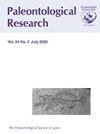过去1.6Ma北大西洋表层水文的两层转换:浮游生物有孔虫的多重证据
IF 0.6
4区 地球科学
Q3 PALEONTOLOGY
引用次数: 0
摘要
摘要对北大西洋综合海洋钻探计划(IODP)U1304站点的浮游有孔虫组合数据、测试形态和稳定氧同位素的分析表明,在0.6 Ma和0.4 Ma左右,即分别在海洋同位素阶段(MISs)15和11期间,洋锋发生了逐步的区域迁移。浮游有孔虫组合和壳碳酸盐同位素的变化都表明,尽管在间冰期,来自大西洋水域的温暖水域偶尔会沐浴在U1304地点,但IODP U1304地点的寒冷北极水域总体上持续了1.6至0.6 Ma(MIS 15)。在约0.6至0.4 Ma的时间间隔内(MISs 15-11),同位素证据表明U1304地点的北极和大西洋水域交替占主导地位。在MIS 11中,优势浮游有孔虫物种厚皮新球虫的试验尺寸出现了短期但显著的下降。试验大小的变化可能是由亚北极锋周围长期间冰期在更喜欢的觅食条件下加速繁殖引起的。这一发现得到了在同一时间间隔内存在大量硅藻泥的支持。地表水系统的现代型冰川/间冰川变化始于约0.4 Ma(MIS 11),发生在中布鲁内斯事件之后。本文章由计算机程序翻译,如有差异,请以英文原文为准。
Two-Tiered Transition of the North Atlantic Surface Hydrology during the Past 1.6 Ma: Multiproxy Evidence from Planktic Foraminifera
Abstract. Analyses of planktic foraminiferal assemblage data, test morphology, and stable oxygen isotopes from the Integrated Ocean Drilling Program (IODP) Site U1304 in the North Atlantic reveal a stepwise regional migration of the oceanic fronts around 0.6 Ma and 0.4 Ma, i.e., during Marine Isotope Stages (MISs) 15 and 11, respectively. Both changes of planktic foraminiferal assemblages and shell carbonate isotopes indicate that the cold Arctic waters in general persisted at IODP Site U1304 from 1.6 to 0.6 Ma (MIS 15), even though the warmer waters originating from the Atlantic waters episodically bathed Site U1304 during the interglacial periods. During the time-interval from ca. 0.6 to 0.4 Ma (MISs 15–11), an alternating dominance of Artic and Atlantic waters at the Site U1304 has been suggested from isotopic evidence. In MIS 11, the dominant planktic foraminiferal species Neogloboquadrina pachyderma experienced a short-term but significant decrease in test size. The test-size change may have been caused by accelerated reproduction in more favorite feeding conditions over the long-lasting interglacial period around the Subarctic Front. This finding is supported by the presence of massive diatoms oozes in the same time-interval. The modern-type glacial/interglacial change of the surface water system established since ca. 0.4 Ma (MIS 11) followed the Mid-Brunhes Event.
求助全文
通过发布文献求助,成功后即可免费获取论文全文。
去求助
来源期刊

Paleontological Research
PALEONTOLOGY-
CiteScore
1.60
自引率
0.00%
发文量
47
审稿时长
>12 weeks
期刊介绍:
Paleonotological Research (PR) is a quarterly, peer-reviewed international journal, which focuses on original contributions primarily in the area of paleontology but also covering a wide range of allied sciences. It has been published since 1997 as a successor to the former journal Transactions and Proceedings of the Palaeontological Society of Japan. The emphasis of contributions will include global and local perspectives, and contents can cover all ages (Precambrian to the Quaternary, including the present time).
 求助内容:
求助内容: 应助结果提醒方式:
应助结果提醒方式:


